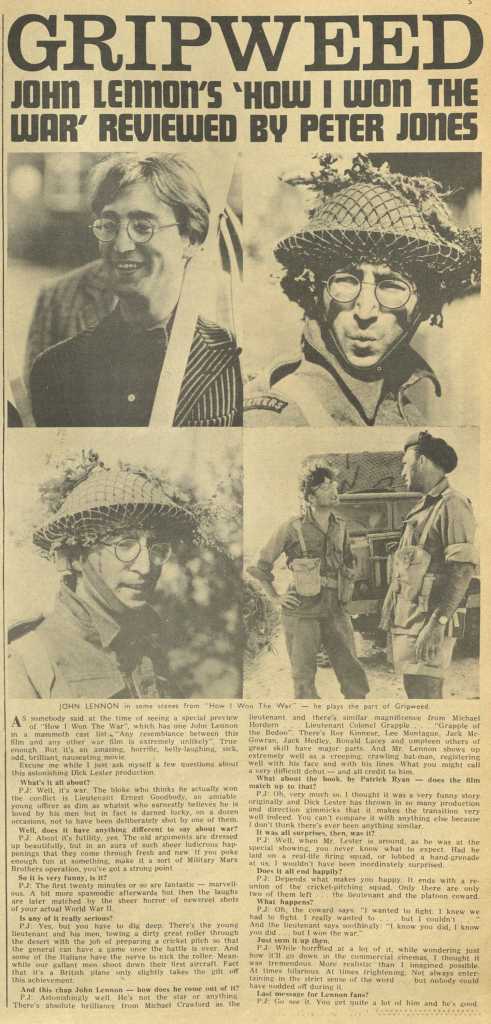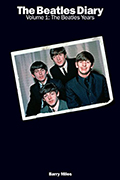Location
Location: London Pavilion, London, UK
Timeline
Article Mid October 1967 • The Beatles and The Rolling Stones discuss ideas for business ventures
Article Oct 17, 1967 • The Beatles attends a memorial service for Brian Epstein
Article Oct 18, 1967 • The Beatles attend the premiere of “How I Won The War”
Session Oct 19, 1967 • Recording "Hello, Goodbye"
Session Oct 20, 1967 • Recording "The Fool On The Hill", "Hello, Goodbye"
Next article Oct 29, 1967 • Filming of “Magical Mystery Tour” • Day 14
Related people
Related articles
On that evening, the four Beatles and their wives or girlfriend attended the London premiere of Richard Lester’s “How I Won The War“, starring John Lennon. Also in attendance were Jim and Angie McCartney, Jimi Hendrix, Cilla Black and Cass Elliot. Afterwards, they went to Cilla Black’s flat for a celebration party.
In 1967, Jim and I attended the London Premiere of How I Won the War, starring John Lennon, and directed by Dick Lester. It was a hilarious fun poke at war, and starred Michael Crawford (before his career as a serious singer), comedic actor Roy Kinnear, and even Neil Aspinall had a small part (uncredited) as a dead soldier.
After the performance, we were all invited back to Cilla Black and Bobby Willis’ apartment in Portland Place.
That was the night that, as we trooped out of the limos to enter the building, a very tipsy gent in top hat, white tie and tails (no, it wasn’t Fred Astaire), staggered up to John Lennon and asked in a very plummy accent: “I say, aren’t you one of those Beatle chappies?” John nodded in agreement, then the man thrust a notebook and pen in John’s hand and said, “Then give me your autograph, it’s for my daughter, I can’t stand you myself.” To which John adroitly responded, “Well f*** off then!”
As we all crowded into the lift to go up to Cilla and Bobby’s flat, Mama Cass was in there too. She had recently been apprehended at Heathrow Airport and accused of taking a blanket from her hotel. Paul stunned us all by saying, “Hi there, blanket thief.” Fortunately she took it in good part and laughed it off, but my dear husband, Gentleman Jim, was mortified.
Angie McCartney – Step-mother of Paul McCartney – From “Angie McCartney: My Long and Winding Road“, 2013
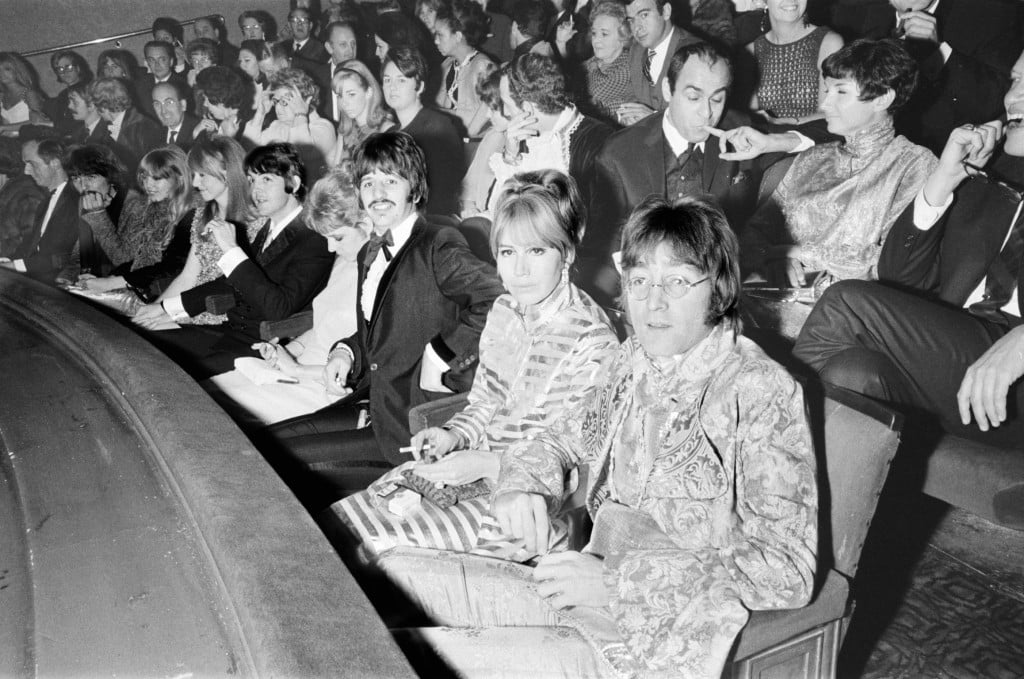
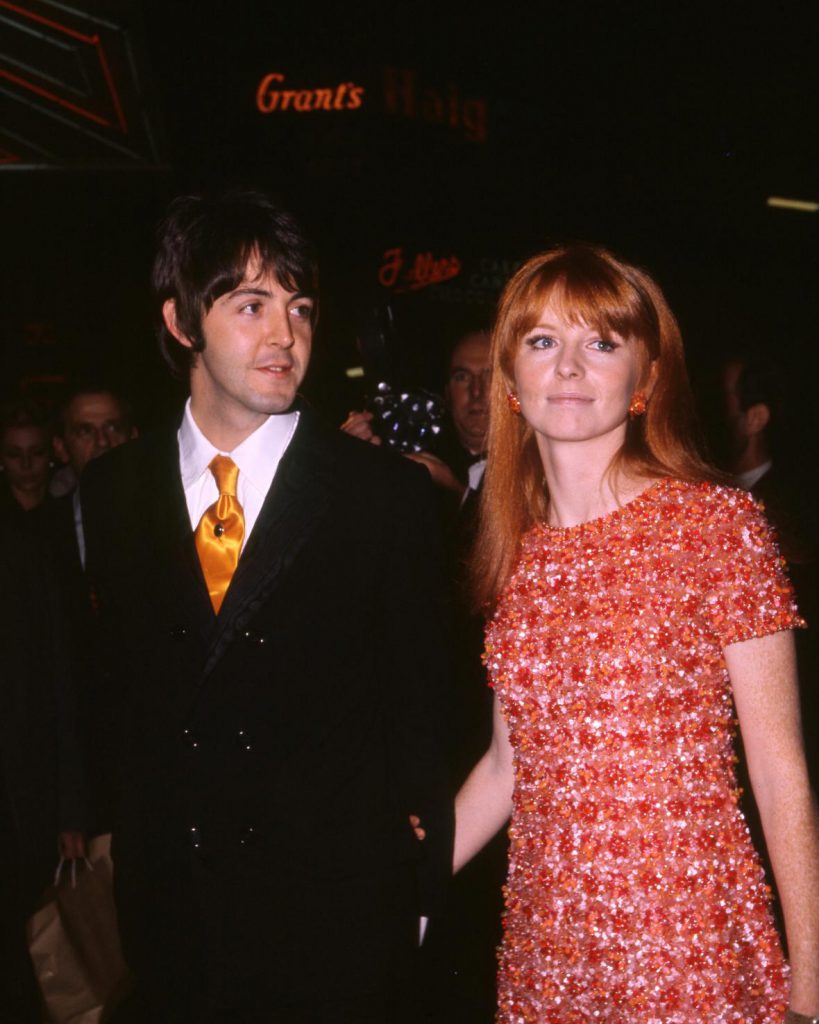
MPL ARCHIVE © PAUL MCCARTNEY/MPL COMMUNICATIONS INC/LTD
From Wikipedia:
How I Won the War is a 1967 British black comedy film starring Michael Crawford, Jack MacGowran, Roy Kinnear, Lee Montague, and John Lennon in his only non-musical acting role. The film, which was directed and produced by Richard Lester, is based upon the 1963 novel of the same name by Patrick Ryan.
The film uses a variety of styles such as vignettes, straight-to-camera, and docu-drama to tell the tale of the fictional 3rd Troop, the 4th Musketeers and their misadventures through the Second World War. The screenplay takes a comic and absurdist attitude towards the conflict through the Western Desert Campaign in mid-late 1942 to the crossing of the last intact bridge on the Rhine at Remagen in early 1945.
Synopsis
Lieutenant Goodbody is an inept, idealistic, naïve, and almost relentlessly jingoistic wartime-commissioned (not regular) officer. One of the main subversive themes in the film is the platoon’s repeated attempts or temptations to kill or otherwise rid themselves of their complete liability of a commander. While Goodbody’s ineptitude and attempts at derring-do lead to the gradual demise of the unit, he survives, together with the unit’s persistent deserter and another of his charges who become confined to psychiatric care. Every time a character is killed, he is replaced by an actor in bright red, blue, or green-coloured Second World War uniform, whose face is also coloured and obscured so that he appears to be a living toy soldier. This reinforces Goodbody’s repeated comparisons of war to playing a game. […]
Writing
In writing the script, the author, Charles Wood, borrowed themes and dialogue from his surreal and bitterly dark (and banned) anti-war play Dingo. In particular the character of the spectral clown “Juniper” is closely modelled on the Camp Comic from the play, who likewise uses a blackly comic style to ridicule the fatuous glorification of war. Goodbody narrates the film retrospectively, more or less, while in conversation with his German officer captor, “Odlebog”, at the Rhine bridgehead in 1945. From their duologue emerges another key source of subversion – the two officers are in fact united in their class attitudes and officer-status contempt for (and ignorance of) their men. While they admit that the question of the massacre of Jews might divide them, they equally admit that it is not of prime concern to either of them. Goodbody’s jingoistic patriotism finally relents when he accepts his German counterpart’s accusation of being, in principle, a Fascist. They then resolve to settle their disagreements on a commercial basis (Odlebog proposes selling Goodbody the last intact bridge over the Rhine; in the novel the bridge is identified as that at Remagen) which could be construed as a satire on unethical business practices and capitalism. This sequence also appears in the novel. Fascism amongst the British is previously mentioned when Gripweed (Lennon’s character) is revealed to be a former follower of Oswald Mosley and the British Union of Fascists, though Colonel Grapple (played by Michael Hordern) sees nothing for Gripweed to be embarrassed about, stressing that “Fascism is something you grow out of”. One monologue in the film concerns Musketeer Juniper’s lament – while impersonating a high-ranked officer – about how officer material is drawn from the working and lower class, and not (as it used to be) from the feudal aristocracy.
Development
Lester decided to make several changes from the source material. For example, the novel does not have an absurdist/surrealist tone like the film. The novel represents a far more conservative, structured (though still comic) war memoir, told by a sarcastically naïve and puerile Lieutenant Goodbody in the first person. It follows an authentic chronology of the war consistent with one of the long-serving regular infantry units – for example of the 4th Infantry Division – such as the 2nd Royal Fusiliers, including (unlike the film) the campaigns in Italy and Greece. Rather than surrealism the novel offers some quite chillingly vivid accounts of Tunis and Cassino. Patrick Ryan served as an infantry and then a reconnaissance officer in the war. Throughout, the author’s bitterness at the pointlessness of war, and the battle of class interests in the hierarchy, are common to the film, as are most of the characters (though the novel predictably includes many more than the film).
In the novel, Patrick Ryan chose not to identify a real army unit. The officers chase wine and glory, the soldiers chase sex and evade the enemy. The model is a regular infantry regiment forced, in wartime, to accept temporarily commissioned officers like Goodbody into its number, as well as returning reservists called back into service. In both world wars this has provided a huge bone of contention for regular regiments, where the exclusive esprit de corps is highly valued and safeguarded. The name Musketeers recalls the Royal Fusiliers, but the later mention of the “Brigade of Musketeers” recalls the Brigade of Guards. In the film, the regiment is presented as a cavalry regiment (armoured with tanks or light armour, such as the half-tracks) that has been adapted to “an independent role as infantry”. The platoon of the novel has become a troop, a Cavalry designation. None of these features come from the novel, such as the use of half-tracks and Transom’s appointment as “corporal of musket”, which suggests the cavalry rank corporal of horse. These aspects are most likely due to the screenwriter Charles Wood being a former regular army cavalryman.
Filming
Filming took place during the autumn of 1966 in the German state of Lower Saxony, at the Bergen-Hohne Training Area, Verden an der Aller and Achim, as well as the Province of Almería in Spain. Lennon, taking a break from the Beatles, was asked by Lester to play Musketeer Gripweed. To prepare for the role, Lennon had a haircut, contrasting sharply with his mop-top image. During filming, he started wearing round “granny” glasses (the same type of glasses worn by the film’s screenwriter, Charles Wood); the glasses became iconic as the nearsighted Lennon mainly wore this particular style of glasses for the rest of his life. A photo of Lennon in character as Gripweed found its way into many print publications, including the front page of the first issue of Rolling Stone in November 1967. Beatles friend, and soon to be head of Apple Corps, Neil Aspinall has a cameo role as a soldier.
During his stay in Almería, Lennon had rented a villa called Santa Isabel that he and wife Cynthia Lennon shared with both his co-star Michael Crawford and his then wife, Gabrielle Lewis. The villa’s wrought-iron gates and surrounding lush vegetation bore a resemblance to Strawberry Field, a Salvation Army garden near Lennon’s childhood home; it was this observation that inspired Lennon to write “Strawberry Fields Forever” while filming. The villa was later turned into the House of Cinema, a museum dedicated to the history of movie production in Almería province. A Spanish film, Living Is Easy with Eyes Closed (2013), revolves around the filming in Almería.
From 28 to 29 December 1966, Lennon recorded all post-synchronisation work for his character at Twickenham Film Studios in London, England.
Release
The film’s release was delayed by six months as Richard Lester went on to work on Petulia (1968) shortly after completing How I Won the War.
Reception
The film holds a “rotten” 54% rating at the film review aggregator website Rotten Tomatoes, receiving 6 negative reviews out of 13. In his review for the film, Roger Ebert gave the movie two stars, describing it as “not a brave or outspoken film”. John Simon called it “pretentious tomfoolery” and Monthly Film Bulletin felt “that Lester has bitten off more than he can chew”.
Stanley Kauffmann of The New Republic described How I Won the War as “the most ruthless mockery of the killer instinct and of patriotism that has ever reached the screen”. […]
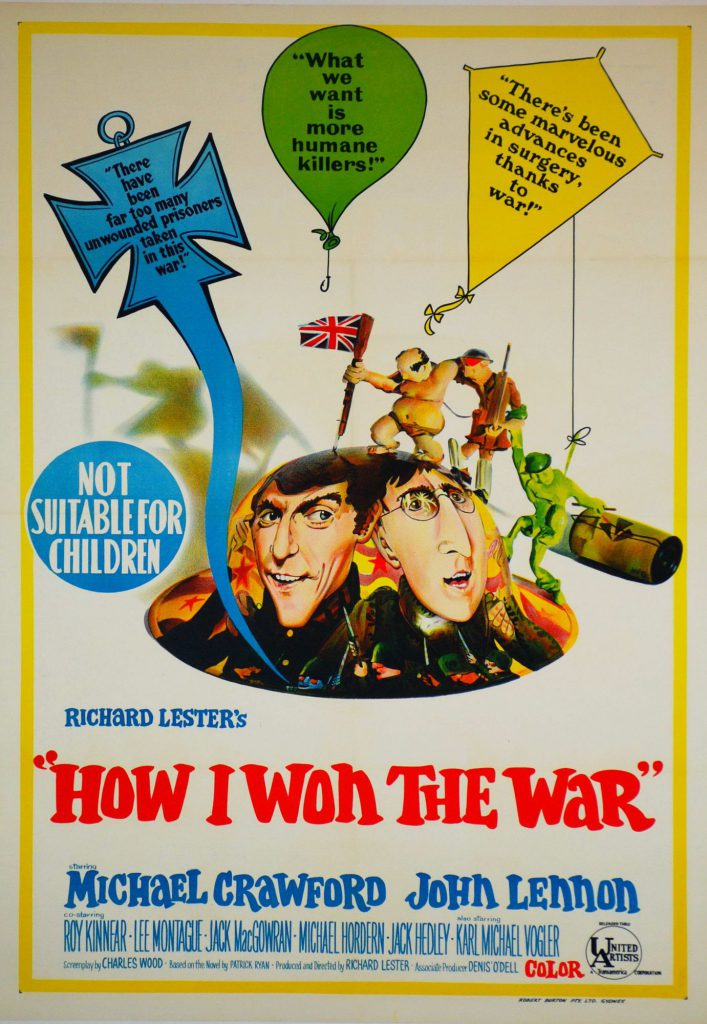
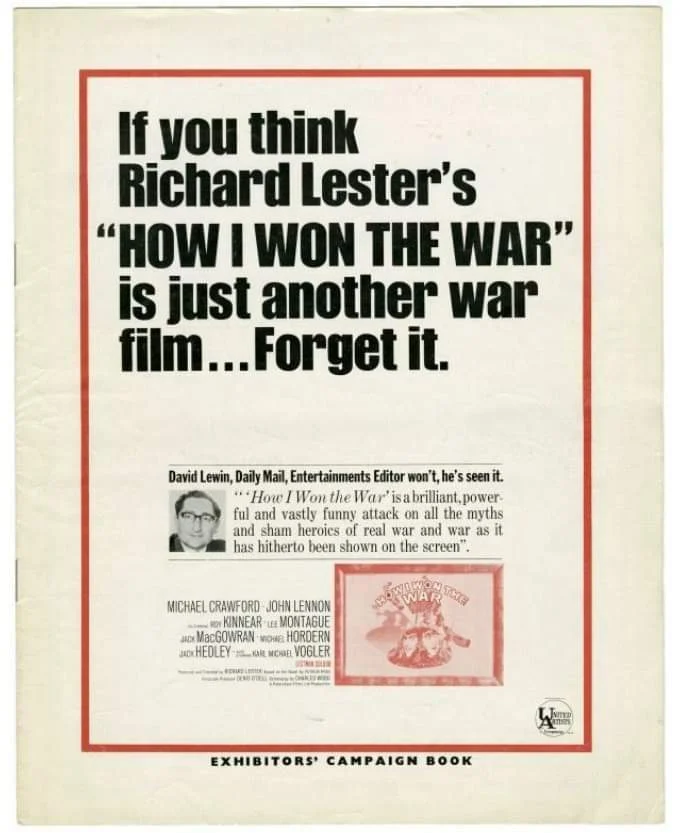
STARS TURN OUT TO SEE JOHN LENNON’S FIRST SOLO FILM
Host to almost countless stars who attended the premiere last Wednesday of his first solo film “How I Won The War” was JOHN LENNON (above) who co-stars with Michael Crawford. The other Beatles, of course, arrived to give moral support for what was, after all, one of the most nerve wracking evenings Beatle John has spent in a long time. PAUL was there with girlfriend JANE ASHER (centre picture above) both conventionally dressed compared to the others, and also there was MAMA CASS (top right) who was rather a surprise first-nighter. Nobody was sure she was even in the country until she turned up!
It wouldn’t have been complete without CILLA BLACK (above) and she was there as radiant as ever and obviously enjoying every star-packed second. This girl is so unaffected by stardom we almost expected to see her rushing around asking for autographs ! (Right) GEORGE HARRISON and wife PATTI as they forced their way past the hordes of photographers.
(Left) RINGO and MAUREEN. Ringo is also considering making his solo debut in a film so he knew how John must be feeling. Almost looks as if he’s more worried than John ! Another first-nighter (above right) was beautiful, sari-clad, ANITA HARRIS and (below right) is JIMI HENDRIX looking as ***** as ever! (Below) casting a professional eye on the proceedings, are DAVID HEMMINGS, star of the controversial “Blow Up” film and his wife, GAIL HUNNICUT.
From New Musical Express – October 28, 1967
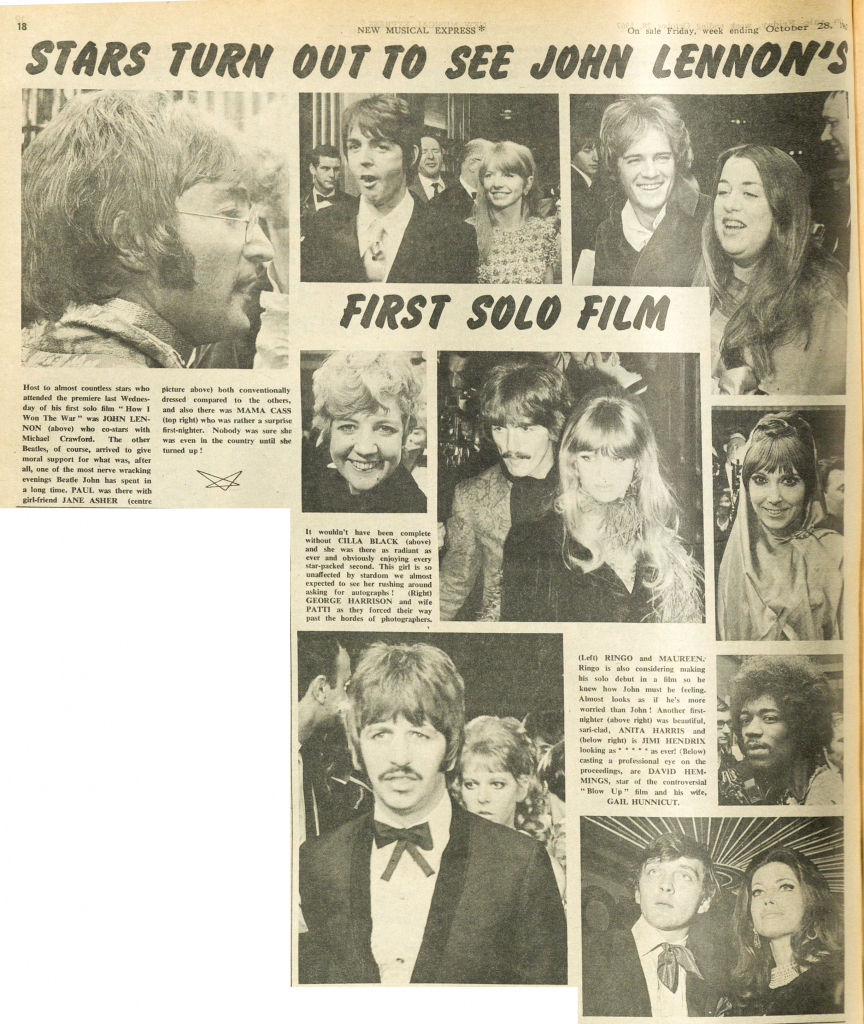
Some stars at the premiere of Dick Lester’s “How I Won The War.” Mr. and Mrs. Manfred Mann, Mr. and Mrs. George Harrison, Mr. and Mrs. John Lennon and of course Paul and Jane.
From Record Mirror – October 28, 1967

